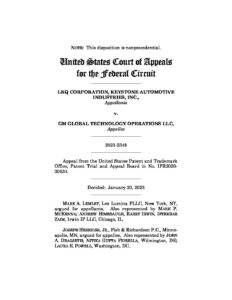By Qi Yu
Recently, the Court of Appeals for the Federal Circuit (“Federal Circuit”) considered whether the test for obviousness articulated by the US Supreme Court in KSR International Co. v. Telflex, Inc., 550 U.S. 398 (2007) (“KSR”) applies to design patents. In LKQ Corp. et al. v. GM Global Technology Operations LLC, the Federal Circuit affirmed the Patent Trial and Appeal Board (“PTAB”) decision that upheld the validity of the design patents at issue.
The Federal Circuit acknowledged the test established in In re Rosen, 673 F.2d 388 (C.C.P.A. 1982) (“Rosen”) and Durling v. Spectrum Furniture Co., Inc., 101 F.3d 100 (Fed. Cir. 1996) (“Durling”), known as the Durling test, for determining obviousness of design patents requires ascertaining: (1) whether there is a primary earlier reference that is “basically the same,” also known as a Rosen reference; and (2) whether it would be obvious for a designer to modify the primary earlier reference to reach a claimed design.
Because it is difficult to find a primary earlier reference that is “basically the same” as a claimed design, the bar for challenging obviousness of design patents is high. In the proceeding before the PTAB, LKQ failed to identify such a primary earlier reference to prove obviousness of GM’s design patents. In the appeal before the Federal Circuit, LKQ argued that the Durling test relied upon by the PTAB for determining obviousness of GM’s design patents has been implicitly overruled by the US Supreme Court’s decision in KSR. As such, LKQ requested that the PTAB decision be vacated and remanded.
The three-judge panel of the Federal Circuit declined to overrule the Durling test without guidance from the US Supreme Court and concluded that the panel is bound to the existing law.
Judge Lourie wrote separately and opined that Rosen is not implicitly overruled by the US Supreme Court in KSR, where a broad concept of “teaching, suggestions, and motivation” is applied in evaluating whether a combination of references renders a claimed invention obvious. Judge Stark also wrote separately and acknowledged that “there is, at minimum, substantial tension between the US Supreme Court’s holding in KSR and our Durling test.”
In sum, the obviousness bar for design patents remains unchanged. However, there is a possibility the Federal Circuit sitting en banc or the US Supreme Court may address the tension, or at least clarify the relationship between the Durling test and the holding in KSR, given that design patents are frequently asserted in IP litigations. Developments in this area are worth watching.

